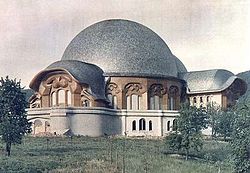Buildings and structures


Buildings opened
- 5 March – Rebuilt Helsinki Central railway station, designed by Eliel Saarinen. [2] [3]
- April – First Congregational Church of Albany, New York, USA, designed by Albert W. Fuller.
- September – Brooklyn Army Terminal, New York, USA, designed by Cass Gilbert.
- 16 October – Condado Vanderbilt Hotel in San Juan, Puerto Rico. [4]
- 11 November (Remembrance Day) – Hart House, University of Toronto, Toronto, Ontario, Canada, designed by Henry Sproatt.
- 27 November – Laie Hawaii Temple, Oahu, Hawaii, USA, dedicated.
- 29 November – Großes Schauspielhaus in Berlin with interior remodelled as a theater by Hans Poelzig.
- Church of the Madonna della Difesa, Montreal, Canada. [5]
- McMahon Building, better known as the "World's littlest skyscraper", by J. D. McMahon, in downtown Wichita Falls, Texas.
Buildings completed
- Het Schip, Amsterdam, Netherlands, by Michel de Klerk.
- First Goetheanum, Dornach, Switzerland, by Rudolf Steiner.
